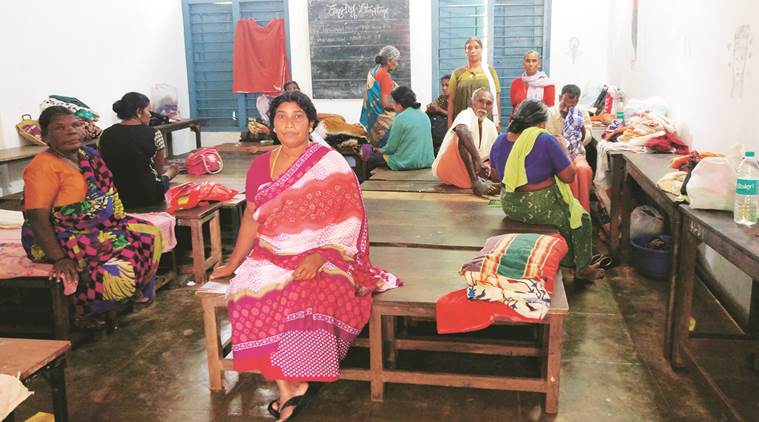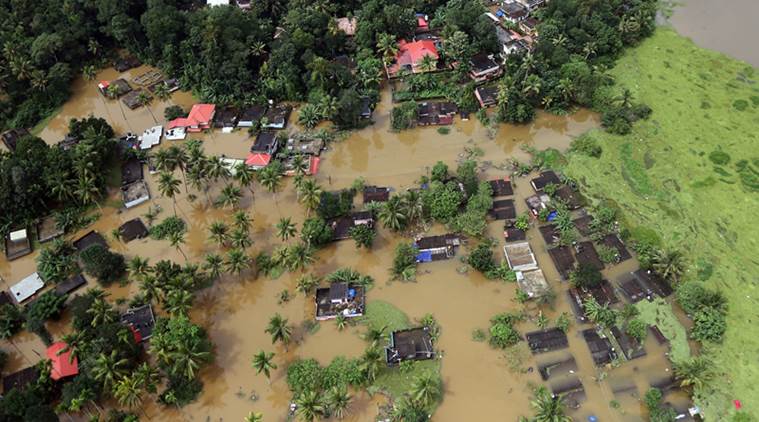 Inside a school that is now a relief camp. (Express Photo by Johnson T A)
Inside a school that is now a relief camp. (Express Photo by Johnson T A)
Standing on the first floor of the Government Higher Secondary School in Elamakkara near Kochi, Indira Velayudhan recalls how the water seeped into her front yard in Makkaparambu on the afternoon of August 15. “Like every monsoon, I thought the water would remain there for a while and then gradually recede into the Perandoor canal,” says the 50-year-old, who is recovering from breast cancer. Except this time, the water didn’t recede. Over the next 24 hours, it seeped its way into her home.
“That’s when we decided to take off. We placed our TV and other appliances on top of cupboards and stashed away Aadhaar, ration card and other documents in a safe place and ran out of there. Somehow, we got into a car and came here,” says Velayudhan, who is on the eastern block of the school that’s reserved for women. Follow LIVE UPDATES Here
The school is one of 2,094 relief camps operating across the state and is one of the biggest such in Ernakulam district. The camp began taking in people from Makkaparambu, Nikathil and Perandoor on the afternoon of August 15, when water began seeping onto the main roads from the Perandoor canal, a natural waterway linking the Periyar river to the Arabian Sea. By Friday evening, however, the school with 45 classrooms had become home to more than 1,200 people, with dozens more surging in. Besides this camp, there are four others in Elamakkara that together account for 850 people. Tracking the unfolding tragedy in Kerala, from Ernakulam to Thrissur
Official sources say the flooding in Elamakkara has been due to the release of water from dams in Idamalayar, Cheruthoni and Mullaperiyar into the Periyar river. Since the Perandoor canal, which flows through Kochi, is linked to the Periyar, water surges into areas such as Elamakkara.
Also Read | Why Kerala has flooded
“This has never happened before. People are naturally scared to see water entering their homes,” said Ravikuttan, the local councillor overseeing arrangements at the camp. He soon calls the headmistress of a nearby school, asking for keys to open the classrooms. “Teacher, our camp at the government school is already full. Please open the classrooms for us. We have to open a sixth camp,” he says.
Valsala, 56, also a resident of Makkaparambu, recalls how her family of five, including her four-year-old granddaughter whom she carried on her shoulders, left all their belongings behind in their flooded, home. “Motham poyi (Everything’s gone),” she cries out. “We ran out of our homes, without even taking spare clothes. We have seen such visuals on TV before and we have cried out ayyo (oh). But it’s only when tragedy strikes us that we realise how terrifying it can be,” says Valsala, who sells lottery tickets with her husband.
 An aerial view shows partially submerged houses at a flooded area in Kerala. (REUTERS)
An aerial view shows partially submerged houses at a flooded area in Kerala. (REUTERS)
As darkness falls, the tubelights in the corridors and classrooms light up. In the men’s wing of the camp, a few of them debate whether they should return to their homes to take stock of the situation. A group of younger men discuss if they should take a shower. “I really, really need a bath, but I can’t do it here in the school toilet. Should we try the washroom in the other school?” a teenager asks his friend.
By 7 pm, the school is teeming with people, who are roaming the corridors and spreading out mats inside the classrooms. Tea and snacks get distributed. Outside, as it rains incessantly, families continue to arrive and register themselves with a local official posted at the camp. On arrival, they are each given straw mats, bed-sheets, pillows, dhotis, undergarments, sanitary napkins and toothbrush-soap-toothpaste kits.
“Most of the essential supplies have been coming to us from private organisations and individuals. We are not worried about stocks at all because we have enough stuff until Sunday,” says a CPM worker who is overseeing the registration at the camp.
Even as reports emerge of relief camps in areas such as Aluva and Paravur complaining of lack of supplies, camps such as this one in Elamakkara have been overflowing with relief materials, pointing to an uneven distribution of supplies. By 8 pm, volunteers bring out steel plates and utensils and place them on a table, beside large vessels filled with rice, sambar, boiled black gram and papad. Food supplies to the neighbouring camps too are sent from this high school. Soon, there are long queues for dinner. Pregnant women and those with infants take their plates to the classrooms. In another corner, boiled eggs and small cups of hot milk get passed on.
Post dinner, people begin making their way back to the classrooms. Pregnant women, aged people and children find space on benches while the others sleep on the floor on mats.
A floor below, in one of the rooms, people line up for medicines for common ailments — headache, toothache and backache — as the nurse prepares to leave.
Outside the medical room, Dileep Kumar, the lone police officer at the camp, stretches himself. An officer should have replaced him by now, but he doesn’t know when that’ll happen. “I’m used to long nights so it doesn’t matter,” he says, listening to news of the floods on his cell phone. “This was bound to happen. This is all because of encroachment,” he says.
As the clock strikes 11, the entire camp is silent, except for the pitter-patter of the rain striking the wet soil.